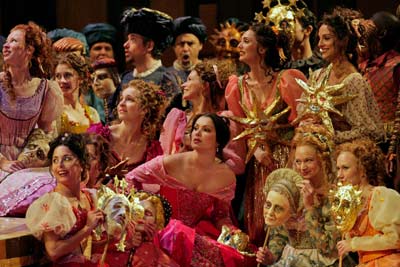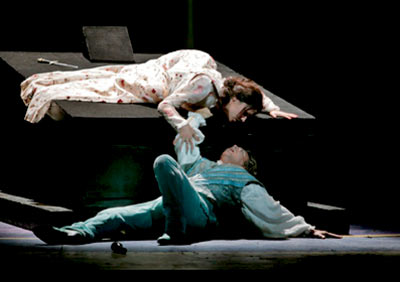The Opera Nut finds he has a very mixed reaction to seeing his first opera of the Met HD 2010 Summer Encore Series. 
Based on my experiences during the year in attending Met HD performances at the Cinemark Theater in Palo Alto I had high expectations when I entered the theater Thursday afternoon about 1 pm.  They were not realized.  Instead of the A or B+ that I would have given every other performance I have seen there, I would label my overall satisfaction C at most.  When I rate the various factors that make up an overall operatic experience, it is an extremely bi-modal distribution:
The Production
Singing
Anna Netrebko    A+
Roberto Alagna    A+
Minor roles    B+
Chorus    A
Acting
Roberto Alagna    A+
Anna Netrebko    A+
Minor roles    B+
Chorus    A
Overall Singing and Acting        A
Music        A
Story        A
Staging
Sets    A+
Costumes    A
Choreography    ?
Lighting    A-
Overall staging        A
Overall Production        A
The Presentation
Starting on time    F
Light control in theater    F
Sound-Picture coordination    F
Sub-Titles    D
Intermissions    F
Overall Presentation    F
I’m the kind of guy who saves the corner of cake with the most frosting for his last bite; I eat my first pancake with bacon and only put syrup on the last one; etc.¬† I like to finish with a good taste in my mouth.¬† Therefore, I’ll talk about the Presentation ratings first.
In most theaters the second¬†Encore¬†showing is at 10:00 local time Thursday.¬† In¬†Palo Alto¬†it was scheduled to start at 1:30.¬† I arrived at 1:00 and found my favorite seat 4th row from the back, center.¬† Irrelevant stuff was showing on the screen; there was no sound.¬† After a few minutes the sound started with orchestra tunings, etc. – sounds we are used to hearing shortly before an opera starts.¬† There is a moment’s hush, a round of applause, and the music starts with what I presume is the overture to¬†Romeo and Juliet.¬† Meanwhile the picture is still irrelevant.¬† Voices join the orchestra.¬† Suddenly the picture switches and we see the opera stage with a large chorus milling about and singing and with subtitles at the bottom.¬† Clearly this is the Prologue to¬†Romeo and Juliet.
But it is still several minutes before 1:30.¬† People are still arriving, talking, finding seats, etc.¬† The door is open letting in a lot of light, which dims the picture on the screen.¬† And, a few minutes later but still before 1:30, the picture switches again to show us the preview of some totally different movie!¬† Oh well, I think.¬† They’re testing things out in the projection room.¬† Hopefully, they’ll get it all straightened out in time, and we’ll start over from the beginning.¬† Hah!
They did finally get the picture bit organized and the real picture came on perfectly synchronized with the music.¬† But they just kept right on going.¬† We missed seeing the entire prologue (which explains my question mark rating of the choreography) and the first few minutes of Act I.¬† The theater door was now closed, but a window in it let through a beam of light.¬† It didn’t affect the screen, but it did light up the seat backs and human heads in the row in front of me, creating a very real distraction to viewing the main screen.¬† Fortunately the theater was not crowded so I moved to a different seat totally out of the line of light.¬† Eventually someone must have turned out a light or closed an outer door and all was well from the lighting viewpoint.
The subtitles were all written in pure white letters.¬† Against most backgrounds they showed up well.¬† But it seemed as if Romeo always wore a white or off-white shirt and Juliet had on a white dress or white nightgown and the bedclothes in Act IV are white.¬† And whenever the camera puts anything white in the subtitle area, the letters are completely invisible.¬† I’ve never had this problem before – and I hope I never have it again.
The trouble with the intermissions is that there weren’t any!¬† Not one.¬† Three plus hours of sitting and watching an opera with no chance to stretch a leg or get a drink or visit a rest room.¬† Can you believe it?¬† Next time I’ll wear Depends.
Obviously, the no intermission policy didn’t work.¬† There was no break in the opera, but at least half the audience needed and took an intermission.¬† Of course that meant that they missed part of the opera, but that was their choice.¬† Miss a few notes or pee in your pants.¬† The trouble is that every person who got up, sidled down the row to the aisle, walked up the aisle, and opened the door disturbed the people who were still in their seats trying to enjoy the opera.
OK, that’s enough griping.¬† Now for the good news.¬† My enjoyment was enhanced by the realization that the orchestra was conducted by¬†Plť°cido Domingo.¬† Thanks to the miracle of¬†HD performances, I had seen him less than 24 hours before singing the title role in a¬†La Scala production of¬†Simon Boccanegra¬†from Milan.¬† Now I was seeing him conduct the¬†New¬†York Metropolitan Opera orchestra¬†from¬†Lincoln¬†Center.¬† Ah, the wonders of Technology.¬† And the wonder of¬†Plť°cido Domingo.
Romeo and Juliet¬†is a wonderful opera and this was a wonderful production of it.¬† The story is very familiar to me, since I have seen¬†Prokofieff’s¬†fantastic ballet many, many times, including going twice to¬†Ballet San Jose’s rendition last winter.¬† But until Thursday I had never seen the opera!
Roberto Alagna¬†and¬†Anna Netrebko¬†are ideal in the title roles.¬†¬† They both have mature voices so I am sure their teen-age years are long gone.¬† But even in the close up views they were two teen-age kids, discovering the wonder of love for the first time.¬† I fell in love with both of them in Act I.¬† They have just met and it’s love-at-first-sight for both; neither knows that the other is a member of the family of their hated rival.¬† Their courtship is so decorous, so innocent, so appealing.¬† All while singing beautiful music, of course.
And their marriage in Act III.¬†¬†Robert Lloyd¬†as Friar Laurence is solemnly singing about the serious religious aspects of marriage.¬† As the young couple kneels before him their voices are harmoniously in complete agreement with him.¬† But their eyes keep darting glances at each other and little smiles break out with the message, “We’ll go along with all this serious stuff, but we both know that it is so insignificant compared to the fact that we are in Love.”¬† I remembered having that same feeling long ago at my own wedding.¬† Thea and I were 20 and 22 – only a few years older than Juliet and Romeo.¬† At one point when the minister was saying something serious I gave Thea a surreptitious wink.¬† You can’t expect me to be objective about an opera when it evokes such pleasant memories.
The stage sets were fantastic.  Set designer Johannes Leiacker eschewed the lush realism for which the Met is so well known in favor of stark simplicity.  The center of the stage usually featured a circular area, slightly raised and modernistically colored.  Since most of the action involves only two people, this device is effective in focusing attention on the couple in what might otherwise seem a distractingly large space.
He also makes great use of different elevations.  This is obvious in the famous balcony scene in Act II, but it is also effective many other places.
In Act IV, for example, Juliet’s bedroom is defined not by walls but by being raised several feet above the main stage; it is accessible only by a short flight of stairs¬†at the rear.¬† And the bed was noticeably higher than the floor.¬† It all helped to really focus attention on the action.
Years ago I heard a talk on “stage fighting”.¬† Stage duels are usually fought with an ep…e, the chief instrument used in the sport of fencing.¬† It is a complex art.¬† Actors don’t need to learn all the fine points, but they do need to learn some basic moves on both offense and defense, and the participants have to be in harmony.¬† For a play without music, actors can have a great deal of leeway as to what moves are used and how long the duel takes.¬† Given this freedom, it is not surprising that the two actors sometimes get out of synch.¬† In real life, that probably means that the one who got out of line would be killed, but in a stage play that might be the wrong guy.¬† Therefore actors are drilled in assuming a fixed “restart” position whenever anything goes wrong.
In an opera or a ballet, there is a much more severe constraint: the music.¬† Every move must be coordinated with the music.¬† Since an error would be intolerable here, the moves must be extremely simple, to the point of sometimes seeming bland and unrealistic.¬† Fight director¬†Dale Anthony Girard¬†solves this problem by staging the duels with daggers rather than ep…es.¬† The result is a fight with lots more apparent contact.¬† Indeed, more than once a contestant is forced off the raised center stage – another¬†example of the height difference adding to the drama.
Throughout the opera¬†Gounod¬†has made substantial changes in¬†Shakespeare’s complex plot to enhance the two principal roles and reduce the significance of all the other characters.¬† This refocusing is taken to an extreme in the final scene in Juliet’s crypt.¬† The first four pages in the play get Paris and Romeo to the crypt where they argue and fight and Paris is killed.¬† Romeo then has less than a page to open the tomb, mourn the apparently dead Juliet, take poison, and die.¬† Here are his last few lines, complete with stage directions:
Here’s to my love!
Drinks
O true apothecary!
Thy drugs are quick. Thus with a kiss I die.
Dies
After a couple of pages devoted to Friar Laurence approaching the crypt, Juliet has only a dozen lines culminating with
O happy dagger!
Snatching ROMEO’s dagger
This is thy sheath;
Stabs herself
there rust, and let me die.
Falls on ROMEO’s body, and dies
Shakespeare¬†then goes on for another 5 pages with everyone who’s left alive coming to the crypt.¬† Capulet and Montague show hitherto unsuspected intelligence, acknowledge that their senseless feud caused this tragedy, shake hands, and resolve to feud no more.
Gounod¬†gives us Romeo and Juliet – and only Romeo and Juliet.¬† He arrives at the crypt, sees her in apparent death lying atop the tomb.¬† He sings of his love for her, of his sadness at her death, and of his determination to join her.¬† He drinks the poison, which in this case is somewhat slower acting.¬† No sooner has he downed it than Juliet awakens and sees him.¬† There is great joy for a few measures until Romeo realizes that he is doomed and bemoans the fact to Juliet who, of course, immediately switches from joy to sorrow.¬† They carry on for a full ten minutes to¬†Gounod’s excruciatingly beautiful music.
Here again, the height factor really adds to the tension.  Juliet is dying on the tombstone, reaching down towards Romeo; he is dying on the floor beside her, reaching up.  As they sing their final duet both are stretching to the utmost for one final physical contact and you see the hands inching closer . . . and closer . . . and closer until they finally reach each other as they sing their final note and expire.
A thoroughly satisfying ending to a lovely tragic opera.
The Opera Nut
Final performance.
Photos:Ken Howard/Metropolitan Opera
This review by Philip G Hodge appeared in sanfranciscosplash.com on June 28, 2010.








